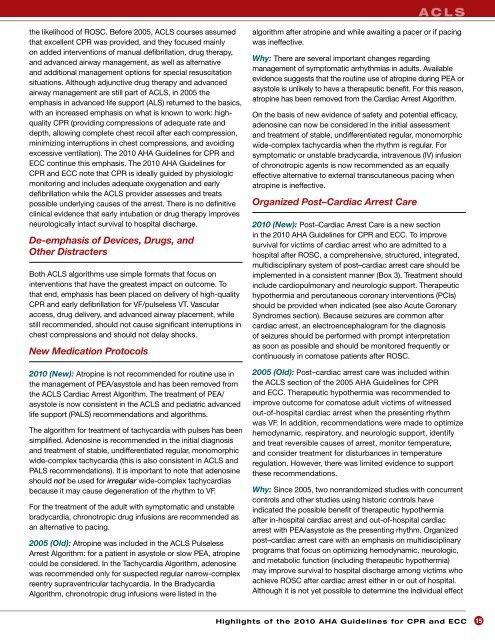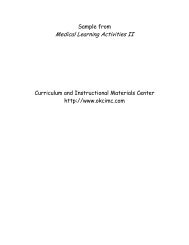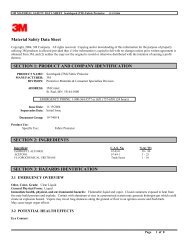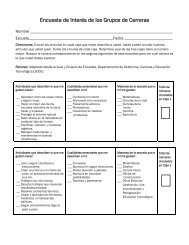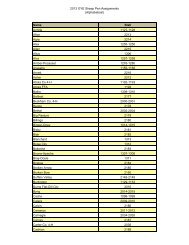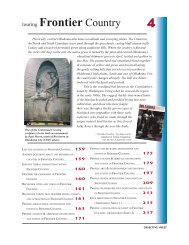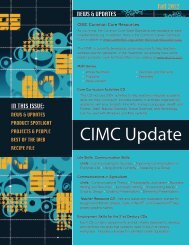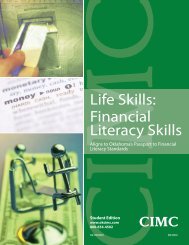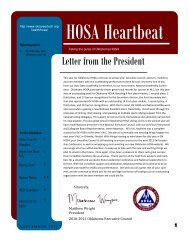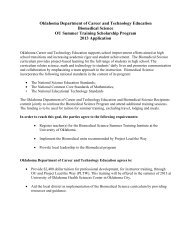Highlights of the 2010 Guidelines for CPR and ECC - ECC Guidelines
Highlights of the 2010 Guidelines for CPR and ECC - ECC Guidelines
Highlights of the 2010 Guidelines for CPR and ECC - ECC Guidelines
You also want an ePaper? Increase the reach of your titles
YUMPU automatically turns print PDFs into web optimized ePapers that Google loves.
A C L S<br />
<strong>the</strong> likelihood <strong>of</strong> ROSC. Be<strong>for</strong>e 2005, ACLS courses assumed<br />
that excellent <strong>CPR</strong> was provided, <strong>and</strong> <strong>the</strong>y focused mainly<br />
on added interventions <strong>of</strong> manual defibrillation, drug <strong>the</strong>rapy,<br />
<strong>and</strong> advanced airway management, as well as alternative<br />
<strong>and</strong> additional management options <strong>for</strong> special resuscitation<br />
situations. Although adjunctive drug <strong>the</strong>rapy <strong>and</strong> advanced<br />
airway management are still part <strong>of</strong> ACLS, in 2005 <strong>the</strong><br />
emphasis in advanced life support (ALS) returned to <strong>the</strong> basics,<br />
with an increased emphasis on what is known to work: highquality<br />
<strong>CPR</strong> (providing compressions <strong>of</strong> adequate rate <strong>and</strong><br />
depth, allowing complete chest recoil after each compression,<br />
minimizing interruptions in chest compressions, <strong>and</strong> avoiding<br />
excessive ventilation). The <strong>2010</strong> AHA <strong>Guidelines</strong> <strong>for</strong> <strong>CPR</strong> <strong>and</strong><br />
<strong>ECC</strong> continue this emphasis. The <strong>2010</strong> AHA <strong>Guidelines</strong> <strong>for</strong><br />
<strong>CPR</strong> <strong>and</strong> <strong>ECC</strong> note that <strong>CPR</strong> is ideally guided by physiologic<br />
monitoring <strong>and</strong> includes adequate oxygenation <strong>and</strong> early<br />
defibrillation while <strong>the</strong> ACLS provider assesses <strong>and</strong> treats<br />
possible underlying causes <strong>of</strong> <strong>the</strong> arrest. There is no definitive<br />
clinical evidence that early intubation or drug <strong>the</strong>rapy improves<br />
neurologically intact survival to hospital discharge.<br />
De-emphasis <strong>of</strong> Devices, Drugs, <strong>and</strong><br />
O<strong>the</strong>r Distracters<br />
Both ACLS algorithms use simple <strong>for</strong>mats that focus on<br />
interventions that have <strong>the</strong> greatest impact on outcome. To<br />
that end, emphasis has been placed on delivery <strong>of</strong> high-quality<br />
<strong>CPR</strong> <strong>and</strong> early defibrillation <strong>for</strong> VF/pulseless VT. Vascular<br />
access, drug delivery, <strong>and</strong> advanced airway placement, while<br />
still recommended, should not cause significant interruptions in<br />
chest compressions <strong>and</strong> should not delay shocks.<br />
New Medication Protocols<br />
<strong>2010</strong> (New): Atropine is not recommended <strong>for</strong> routine use in<br />
<strong>the</strong> management <strong>of</strong> PEA/asystole <strong>and</strong> has been removed from<br />
<strong>the</strong> ACLS Cardiac Arrest Algorithm. The treatment <strong>of</strong> PEA/<br />
asystole is now consistent in <strong>the</strong> ACLS <strong>and</strong> pediatric advanced<br />
life support (PALS) recommendations <strong>and</strong> algorithms.<br />
The algorithm <strong>for</strong> treatment <strong>of</strong> tachycardia with pulses has been<br />
simplified. Adenosine is recommended in <strong>the</strong> initial diagnosis<br />
<strong>and</strong> treatment <strong>of</strong> stable, undifferentiated regular, monomorphic<br />
wide-complex tachycardia (this is also consistent in ACLS <strong>and</strong><br />
PALS recommendations). It is important to note that adenosine<br />
should not be used <strong>for</strong> irregular wide-complex tachycardias<br />
because it may cause degeneration <strong>of</strong> <strong>the</strong> rhythm to VF.<br />
For <strong>the</strong> treatment <strong>of</strong> <strong>the</strong> adult with symptomatic <strong>and</strong> unstable<br />
bradycardia, chronotropic drug infusions are recommended as<br />
an alternative to pacing.<br />
2005 (Old): Atropine was included in <strong>the</strong> ACLS Pulseless<br />
Arrest Algorithm: <strong>for</strong> a patient in asystole or slow PEA, atropine<br />
could be considered. In <strong>the</strong> Tachycardia Algorithm, adenosine<br />
was recommended only <strong>for</strong> suspected regular narrow-complex<br />
reentry supraventricular tachycardia. In <strong>the</strong> Bradycardia<br />
Algorithm, chronotropic drug infusions were listed in <strong>the</strong><br />
algorithm after atropine <strong>and</strong> while awaiting a pacer or if pacing<br />
was ineffective.<br />
Why: There are several important changes regarding<br />
management <strong>of</strong> symptomatic arrhythmias in adults. Available<br />
evidence suggests that <strong>the</strong> routine use <strong>of</strong> atropine during PEA or<br />
asystole is unlikely to have a <strong>the</strong>rapeutic benefit. For this reason,<br />
atropine has been removed from <strong>the</strong> Cardiac Arrest Algorithm.<br />
On <strong>the</strong> basis <strong>of</strong> new evidence <strong>of</strong> safety <strong>and</strong> potential efficacy,<br />
adenosine can now be considered in <strong>the</strong> initial assessment<br />
<strong>and</strong> treatment <strong>of</strong> stable, undifferentiated regular, monomorphic<br />
wide-complex tachycardia when <strong>the</strong> rhythm is regular. For<br />
symptomatic or unstable bradycardia, intravenous (IV) infusion<br />
<strong>of</strong> chronotropic agents is now recommended as an equally<br />
effective alternative to external transcutaneous pacing when<br />
atropine is ineffective.<br />
Organized Post–Cardiac Arrest Care<br />
<strong>2010</strong> (New): Post–Cardiac Arrest Care is a new section<br />
in <strong>the</strong> <strong>2010</strong> AHA <strong>Guidelines</strong> <strong>for</strong> <strong>CPR</strong> <strong>and</strong> <strong>ECC</strong>. To improve<br />
survival <strong>for</strong> victims <strong>of</strong> cardiac arrest who are admitted to a<br />
hospital after ROSC, a comprehensive, structured, integrated,<br />
multidisciplinary system <strong>of</strong> post–cardiac arrest care should be<br />
implemented in a consistent manner (Box 3). Treatment should<br />
include cardiopulmonary <strong>and</strong> neurologic support. Therapeutic<br />
hypo<strong>the</strong>rmia <strong>and</strong> percutaneous coronary interventions (PCIs)<br />
should be provided when indicated (see also Acute Coronary<br />
Syndromes section). Because seizures are common after<br />
cardiac arrest, an electroencephalogram <strong>for</strong> <strong>the</strong> diagnosis<br />
<strong>of</strong> seizures should be per<strong>for</strong>med with prompt interpretation<br />
as soon as possible <strong>and</strong> should be monitored frequently or<br />
continuously in comatose patients after ROSC.<br />
2005 (Old): Post–cardiac arrest care was included within<br />
<strong>the</strong> ACLS section <strong>of</strong> <strong>the</strong> 2005 AHA <strong>Guidelines</strong> <strong>for</strong> <strong>CPR</strong><br />
<strong>and</strong> <strong>ECC</strong>. Therapeutic hypo<strong>the</strong>rmia was recommended to<br />
improve outcome <strong>for</strong> comatose adult victims <strong>of</strong> witnessed<br />
out-<strong>of</strong>-hospital cardiac arrest when <strong>the</strong> presenting rhythm<br />
was VF. In addition, recommendations were made to optimize<br />
hemodynamic, respiratory, <strong>and</strong> neurologic support, identify<br />
<strong>and</strong> treat reversible causes <strong>of</strong> arrest, monitor temperature,<br />
<strong>and</strong> consider treatment <strong>for</strong> disturbances in temperature<br />
regulation. However, <strong>the</strong>re was limited evidence to support<br />
<strong>the</strong>se recommendations.<br />
Why: Since 2005, two nonr<strong>and</strong>omized studies with concurrent<br />
controls <strong>and</strong> o<strong>the</strong>r studies using historic controls have<br />
indicated <strong>the</strong> possible benefit <strong>of</strong> <strong>the</strong>rapeutic hypo<strong>the</strong>rmia<br />
after in-hospital cardiac arrest <strong>and</strong> out-<strong>of</strong>-hospital cardiac<br />
arrest with PEA/asystole as <strong>the</strong> presenting rhythm. Organized<br />
post–cardiac arrest care with an emphasis on multidisciplinary<br />
programs that focus on optimizing hemodynamic, neurologic,<br />
<strong>and</strong> metabolic function (including <strong>the</strong>rapeutic hypo<strong>the</strong>rmia)<br />
may improve survival to hospital discharge among victims who<br />
achieve ROSC after cardiac arrest ei<strong>the</strong>r in or out <strong>of</strong> hospital.<br />
Although it is not yet possible to determine <strong>the</strong> individual effect<br />
<strong>Highlights</strong> <strong>of</strong> <strong>the</strong> <strong>2010</strong> AHA <strong>Guidelines</strong> <strong>for</strong> <strong>CPR</strong> <strong>and</strong> <strong>ECC</strong> 15


